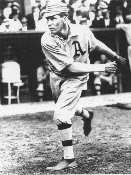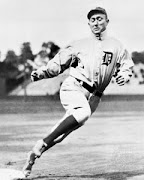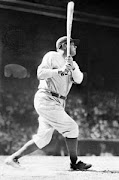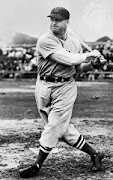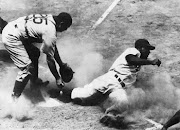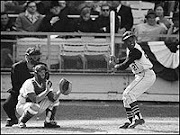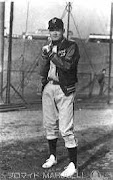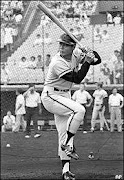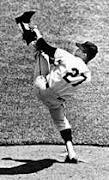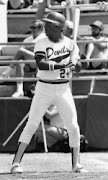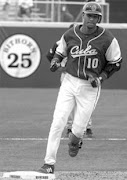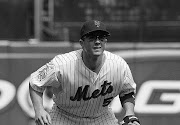Let's face it, this has been one of the most intriguing offseasons in recent memory. There have been many interesting storylines playing out in front of the backdrop of a worldwide recession. Now, essentially one week from pitchers and catchers reporting to spring training, there are still several significant free agents on the market. Let's take a look at where they are most likely to end up:
Orlando Cabrera
Cabrera is a decent defensive shortstop with some talent at the plate. He is definitely in decline. He is still of some value, but most likely much less than the $7 mil per he had been looking for.
Most likely suitors:
Atlanta Braves
Oakland Athletics
Atlanta could find a way to fit Cabrera in, but it might not be worth dealing Escobar. Oakland would only be in if the price were right.
Best fit:
Oakland
Juan Cruz
Cruz is a very solid reviever. His biggest issue this offseason has not been lack of talent or teams that could use his services, it is his Type A free agent status. While Cruz certainly pitched like a Type A last year, teams are not willing to give up a first round draft pick, who will have a solid chance of surpassing Cruz 3 years down the road, for a solid reliever who might only help for a season or two.
Most likely suitors:
New York Yankees
Detroit Tigers
The Yankees would be a good fit, but have shown limited interest. The fact that the Yankees wouldn't have as much concern about the draft pick seems to link their name to Cabrera's. Very unlikely the Tigers would make this move, due to the draft pick.
Best fit:
Minnesota Twins
Bobby Abreu
Once said to be looking for a 4 year $56 million deal, Abreu is now anxiously seeking a one-year deal in perhaps the $7 million range. Sadly, Abreu may have to come down even farther to gain serious interest.
Most likely suitors:
Atlanta Braves
Chicago White Sox
Los Angeles Dodgers
The Braves are in desperate need of an outfield bat, but after the acquisition of Lowe, Vazquez, etc. it remains to be seen if they have anymore financial flexibility. The White Sox would most likely have to find a suitor for Jermaine Dye before seriously considering Abreu. This seems unlikely since Dye is vastly overpriced relative to the market. The Dodgers' interest seems to be limited to calling Manny's bluff.
Best fit:
Atlanta Braves
Orlando Hudson
Solid talent, with a couple of strong years ahead of him. Some freak injuries seem to hurt his already sagging market.
Most likely suitors:
Washington Nationals
Los Angeles Dodgers
New York Mets
The Nationals seem interested, but are being very patient looking for a bargain. The Dodgers will only sign Hudson if they miss out on Ramirez or there is an even greater drop in price. The Mets could only make a move if Omar Minaya pulled off a miracle and moved Luis Castillo.
Best fit:
Washington Nationals
Adam Dunn
A controversial figure: despised by traditionalists, embraced by statistical analysts. Dunn could make almost any lineup better, he could also make almost any outfield defense worse. The upside is greater than the downside, but he is still struggling to find a real market.
Most likely suitors:
Washington Nationals
Atlanta Braves
The Nationals will make a move if no one else does. They would be ecstatic if both Hudson and Dunn fell into their laps at an affordable price. The Braves could use his bat, but seem very wary of the Ks and the defense.
Best fit:
New York Mets
Manny Ramirez
Unbelievable talent. Future first ballot hall of famer. Great entertainer. Clutch Hitter. Poor financial decision maker.
Most likely suitors:
Los Angeles Dodgers
San Francisco Giants
The baseball world would be collectively shocked if Manny didn't sign with the Dodgers.
Best fit:
New York Mets
06 February, 2009
20 January, 2009
Clock Ticking on Free Agent Outfielders
There are three difference-making outfielders left on the free agent market. Manny Ramirez is far and away the greatest of the three, but of the remaining two, Adam Dunn and Bobby Abreu, who would be the better acquisition? Let's take an in-depth look at these two outfielders.
Let's start off by looking at how each of Bobby Abreu and Adam Dunn stack up in the categories of the five basic tools: hitting for average, hitting for power, running, throwing, and fielding.
Hitting for Average:
Abreu
1998 - .312 in 497 at-bats
1999 - .335, 546 ab
2000 - .316, 576 ab
2001 - .289, 588 ab
2002 - .308, 572 ab
2003 - .300, 577 ab
2004 - .301, 574 ab
2005 - .286, 588 ab
2006 - .297, 548 ab
2007 - .283, 605 ab
2008 - .296, 609 ab

Dunn
2001 - .262 in 244 at-bats
2002 - .249, 535 ab
2003 - .215, 381 ab
2004 - .266, 568 ab
2005 - .247, 543 ab
2006 - .234, 561 ab
2007 - .264, 522 ab
2008 - .236, 517 ab
Abreu is by far the greater hitter for average.
Hitting for Power:
Abreu
1998 - .497 SLG, 17 HR
1999 - .549, 20 HR
2000 - .554, 25 HR
2001 - .543, 31 HR
2002 - .521, 20 HR
2003 - .468, 20 HR
2004 - .544, 30 HR
2005 - .474, 24 HR
2006 - .462, 15 HR
2007 - .445, 16 HR
2008 - .471, 20 HR
Dunn
2001 - .578 SLG, 19 HR
2002 - .454, 26 HR
2003 - .465, 27 HR
2004 - .569, 46 HR
2005 - .540, 40 HR
2006 - .490, 40 HR
2007 - .554, 40 HR
2008 - .513, 40 HR
To emphasize how big of a landslide this is for Dunn let's compare his Isolated Power with Abreu's:
Abreu
1998 - .185
1999 - .214
2000 - .238
2001 - .253
2002 - .213
2003 - .168
2004 - .242
2005 - .189
2006 - .164
2007 - .162
2008 - .176
Dunn
2001- .316
2002 - .206
2003 - .249
2004 - .303
2005 - .293
2006 - .257
2007 - .289
2008 - .277
Abreu's best IsoP season is barely better than Dunn's second worst. There is really no comparison between their power.
Before we leave the subject of hitting there is something that must be addressed when discussing these two players: on-base percentage. Both of the players are phenomenal at drawing walks.
Let's compare the two:
Abreu
1998 - .409 OBP, 14.5 BB%
1999 - .446, 16.6
2000 - .416, 14.8
2001 - .393, 15.3
2002 - .413, 15.4
2003 - .409, 15.9
2004 - .428, 18.1
2005 - .405, 16.6
2006 - .424, 18.5
2007 - .369, 12.2
2008 - .371, 10.7
Dunn
2001 - .371 OBP, 13.5 BB%
2002 - .400, 19.3
2003 - .354, 16.3
2004 - .388, 16.0
2005 - .387, 17.4
2006 - .365, 16.6
2007 - .386, 16.2
2008 - .386, 19.1
Abreu's average has already been accounted for and we know that it is far superior to Dunn's. We include BB% here to illustrate that both players are extremely talented in the art of drawing a walk. Excluding average from the inflation of the OBP these players are roughly even with Adam Dunn having a slight edge in the ability to get on-base aside from hits.
Running:
Abreu
1998 - 19 SB
1999 - 27 SB
2000 - 28 SB
2001 - 36 SB
2002 - 31 SB
2003 - 22 SB
2004 - 40 SB
2005 - 31 SB, -1.8
2006 - 30 SB, 5.3 EqBRR
2007 - 25 SB, 0.1 EqBRR
2008 - 22 SB, -.6 EqBRR
Dunn
2001 - 4 SB
2002 - 19 SB
2003 - 8 SB
2004 - 6 SB
2005 - 4 SB, -2.6 EqBRR
2006 - 7 SB, -0.8 EqBRR
2007 - 9 SB, 1.6 EqBRR
2008 - 2, -2.6 EqBRR
Surprisingly Bobby Abreu doesn't grab a huge lead here. He is certainly a much bigger threat to steal a base, but looking at Baseball Prospectus's Equivalent Base-running Runs Abreu is not a huge factor on the base paths. He had a great year in 2006, but the last couple of seasons have been about average. He is slightly ahead of Dunn, but not by a monumental amount. It is important to note that the EqBRR is a much better way of measuring a baserunner's worth than stolen bases, because in addition to steals and caught stealing EqBRR takes into account running on hits, sacrifices, and being thrown out in similar situations.
Now when it comes to throwing and fielding for these players both are lackluster. Since there is a dearth of fielding statistics we'll view throwing and fielding collectively through the fielding statistic UZR/150. This takes into account both throwing and fielding so it will be useful to us in our current examination. (We have used accounting notation by reflecting negative values in parantheses).
Throwing and Fielding:
Abreu
2002 - 6.7
2003 - 13.4
2004 - (10.4)
2005 - (6.9)
2006 - (14.8)
2007 - (3.9)
2008 - (25.9)
Dunn
2002 - 1.0
2003 - (4.7)
2004 - (6.6)
2005 - (14.7)
2006 - (11.0)
2007 - (16.3)
2008 - (22.6)
We have only included the statistics accumulated in the outfield since we are valuing them as outfielders. As you can see neither player is a particularly talented defensive outfielder. When Abreu was younger he was able to make up for some of his shortcomings with his speed, but now neither player is effective and is in fact quite a detriment.
Let's take a look at the cumulative value of these players over the past 6 seasons. We will look at their season-by-season VORP and their defensive runs allowed/prevented relative to replacement level:
Abreu
2003 - 43.0 VORP, 0 runs prevented
2004 - 73.5, 2
2005 - 47.1, -17
2006 - 49.0, -3
2007 - 27.9, -2
2008 - 33.2, -6
Dunn
2003 - 10.1, -6
2004 - 53.4, -17
2005 - 45.0, -11
2006 - 23.5, -13
2007 - 45.5, -17
2008 - 36.6, -10
Overall, offensively Adam Dunn is a more productive outfielder. Defensively however, as bad as Abreu is, he's not as bad as Adam Dunn. The offensive upside of Adam Dunn is likely to negate the greater negative that his defense provides, making him a slightly better choice than Bobby Abreu.
Another factor that can easily be seen in these statistics is age. Bobby Abreu is certainly on the downhill side of a very nice career. Adam Dunn is still in his prime years. One alarming statistic is Bobby Abreu's decline in walk percentage, one of his greatest assets throughout his career.
Using baseball age (age as of July 1 of the season in question), Bobby Abreu is 35 while Adam Dunn is only 29. This is huge difference when looking at these two players. If contract considerations are equal a team should look to add Adam Dunn before Bobby Abreu. While Abreu may have a couple more serviceable seasons in him, those seasons will almost certainly be less valuable than Adam Dunn's.
So what are these players worth on the market today? CHONE places Abreu's value at $10.6 million for average defense ($4.8 mil for putrid defense and $7.5 mil for poor defense), and Dunn's value at $12.8 million for average defense ($6.6 mil for putrid defense and $9.7 mil for poor defense).
Using CHONE's values at poor defense (being optimistic) and projecting a slight decline for 2010 and 2011:
Abreu is worth 3/$19 mil with even distribution of payments.
Dunn is worth 3/$26.6 mil with even distribution of payments.
Using our own projections we value them at:
Abreu is worth 3/$22.2 mil with even distribution of payments.
Dunn is worth 3/$27.0 mil with even distribution of payments.
Teams in need of outfield offensive help should strongly consider either Abreu or Dunn, but especially Dunn if the market continues to sag for these two professional hitters.
Let's start off by looking at how each of Bobby Abreu and Adam Dunn stack up in the categories of the five basic tools: hitting for average, hitting for power, running, throwing, and fielding.
Hitting for Average:
Abreu
1998 - .312 in 497 at-bats
1999 - .335, 546 ab
2000 - .316, 576 ab
2001 - .289, 588 ab
2002 - .308, 572 ab
2003 - .300, 577 ab
2004 - .301, 574 ab
2005 - .286, 588 ab
2006 - .297, 548 ab
2007 - .283, 605 ab
2008 - .296, 609 ab

Dunn
2001 - .262 in 244 at-bats
2002 - .249, 535 ab
2003 - .215, 381 ab
2004 - .266, 568 ab
2005 - .247, 543 ab
2006 - .234, 561 ab
2007 - .264, 522 ab
2008 - .236, 517 ab
Abreu is by far the greater hitter for average.
Hitting for Power:
Abreu
1998 - .497 SLG, 17 HR
1999 - .549, 20 HR
2000 - .554, 25 HR
2001 - .543, 31 HR
2002 - .521, 20 HR
2003 - .468, 20 HR
2004 - .544, 30 HR
2005 - .474, 24 HR
2006 - .462, 15 HR
2007 - .445, 16 HR
2008 - .471, 20 HR
Dunn
2001 - .578 SLG, 19 HR
2002 - .454, 26 HR
2003 - .465, 27 HR
2004 - .569, 46 HR
2005 - .540, 40 HR
2006 - .490, 40 HR
2007 - .554, 40 HR
2008 - .513, 40 HR
To emphasize how big of a landslide this is for Dunn let's compare his Isolated Power with Abreu's:
Abreu
1998 - .185
1999 - .214

2000 - .238
2001 - .253
2002 - .213
2003 - .168
2004 - .242
2005 - .189
2006 - .164
2007 - .162
2008 - .176
Dunn
2001- .316
2002 - .206
2003 - .249
2004 - .303
2005 - .293
2006 - .257
2007 - .289
2008 - .277
Abreu's best IsoP season is barely better than Dunn's second worst. There is really no comparison between their power.
Before we leave the subject of hitting there is something that must be addressed when discussing these two players: on-base percentage. Both of the players are phenomenal at drawing walks.
Let's compare the two:
Abreu
1998 - .409 OBP, 14.5 BB%
1999 - .446, 16.6
2000 - .416, 14.8
2001 - .393, 15.3
2002 - .413, 15.4
2003 - .409, 15.9
2004 - .428, 18.1
2005 - .405, 16.6
2006 - .424, 18.5
2007 - .369, 12.2
2008 - .371, 10.7
Dunn
2001 - .371 OBP, 13.5 BB%
2002 - .400, 19.3
2003 - .354, 16.3
2004 - .388, 16.0
2005 - .387, 17.4
2006 - .365, 16.6
2007 - .386, 16.2
2008 - .386, 19.1
Abreu's average has already been accounted for and we know that it is far superior to Dunn's. We include BB% here to illustrate that both players are extremely talented in the art of drawing a walk. Excluding average from the inflation of the OBP these players are roughly even with Adam Dunn having a slight edge in the ability to get on-base aside from hits.
Running:
Abreu
1998 - 19 SB
1999 - 27 SB
2000 - 28 SB
2001 - 36 SB
2002 - 31 SB
2003 - 22 SB
2004 - 40 SB
2005 - 31 SB, -1.8
2006 - 30 SB, 5.3 EqBRR
2007 - 25 SB, 0.1 EqBRR
2008 - 22 SB, -.6 EqBRR
Dunn
2001 - 4 SB
2002 - 19 SB
2003 - 8 SB
2004 - 6 SB
2005 - 4 SB, -2.6 EqBRR
2006 - 7 SB, -0.8 EqBRR
2007 - 9 SB, 1.6 EqBRR
2008 - 2, -2.6 EqBRR
Surprisingly Bobby Abreu doesn't grab a huge lead here. He is certainly a much bigger threat to steal a base, but looking at Baseball Prospectus's Equivalent Base-running Runs Abreu is not a huge factor on the base paths. He had a great year in 2006, but the last couple of seasons have been about average. He is slightly ahead of Dunn, but not by a monumental amount. It is important to note that the EqBRR is a much better way of measuring a baserunner's worth than stolen bases, because in addition to steals and caught stealing EqBRR takes into account running on hits, sacrifices, and being thrown out in similar situations.
Now when it comes to throwing and fielding for these players both are lackluster. Since there is a dearth of fielding statistics we'll view throwing and fielding collectively through the fielding statistic UZR/150. This takes into account both throwing and fielding so it will be useful to us in our current examination. (We have used accounting notation by reflecting negative values in parantheses).
Throwing and Fielding:
Abreu
2002 - 6.7
2003 - 13.4
2004 - (10.4)
2005 - (6.9)
2006 - (14.8)
2007 - (3.9)
2008 - (25.9)
Dunn
2002 - 1.0
2003 - (4.7)
2004 - (6.6)
2005 - (14.7)
2006 - (11.0)
2007 - (16.3)
2008 - (22.6)
We have only included the statistics accumulated in the outfield since we are valuing them as outfielders. As you can see neither player is a particularly talented defensive outfielder. When Abreu was younger he was able to make up for some of his shortcomings with his speed, but now neither player is effective and is in fact quite a detriment.
Let's take a look at the cumulative value of these players over the past 6 seasons. We will look at their season-by-season VORP and their defensive runs allowed/prevented relative to replacement level:
Abreu
2003 - 43.0 VORP, 0 runs prevented
2004 - 73.5, 2
2005 - 47.1, -17
2006 - 49.0, -3
2007 - 27.9, -2
2008 - 33.2, -6
Dunn
2003 - 10.1, -6
2004 - 53.4, -17
2005 - 45.0, -11
2006 - 23.5, -13
2007 - 45.5, -17
2008 - 36.6, -10
Overall, offensively Adam Dunn is a more productive outfielder. Defensively however, as bad as Abreu is, he's not as bad as Adam Dunn. The offensive upside of Adam Dunn is likely to negate the greater negative that his defense provides, making him a slightly better choice than Bobby Abreu.
Another factor that can easily be seen in these statistics is age. Bobby Abreu is certainly on the downhill side of a very nice career. Adam Dunn is still in his prime years. One alarming statistic is Bobby Abreu's decline in walk percentage, one of his greatest assets throughout his career.
Using baseball age (age as of July 1 of the season in question), Bobby Abreu is 35 while Adam Dunn is only 29. This is huge difference when looking at these two players. If contract considerations are equal a team should look to add Adam Dunn before Bobby Abreu. While Abreu may have a couple more serviceable seasons in him, those seasons will almost certainly be less valuable than Adam Dunn's.
So what are these players worth on the market today? CHONE places Abreu's value at $10.6 million for average defense ($4.8 mil for putrid defense and $7.5 mil for poor defense), and Dunn's value at $12.8 million for average defense ($6.6 mil for putrid defense and $9.7 mil for poor defense).
Using CHONE's values at poor defense (being optimistic) and projecting a slight decline for 2010 and 2011:
Abreu is worth 3/$19 mil with even distribution of payments.
Dunn is worth 3/$26.6 mil with even distribution of payments.
Using our own projections we value them at:
Abreu is worth 3/$22.2 mil with even distribution of payments.
Dunn is worth 3/$27.0 mil with even distribution of payments.
Teams in need of outfield offensive help should strongly consider either Abreu or Dunn, but especially Dunn if the market continues to sag for these two professional hitters.
Labels:
Adam Dunn,
Baseball,
Bobby Abreu,
Free Agent,
Manny Ramirez,
MLB,
Sabermetrics
17 January, 2009
Effectively Wild
Recently the New York Mets decided to pass on Derek Lowe because they did not want to overpay. Our previous analysis shows that the Braves did indeed overpay and the Mets were wise to turn their attention elsewhere. Now the Mets are said to be strongly pursuing Oliver Perez, and were reported to have offered him 3 years, $30 million.
Looking at what Oliver Perez has done in his career thus far, CHONE projects Perez's value over the next five seasons to be:
2009 - $6.7 mil
2010 - $6.9
2011 - $6.6
2012 - $5.6
2013 - $4.9
Due to projected WAR values of:
2009 - 1.5
2010 - 1.4
2011 - 1.2
2012 - 1.0
2013 - 0.8
Because of Oliver Perez's wildness let's assume that these projections are pessimistic. Let's instead suppose that Perez starts to obtain some of the control that could make him great and he improves his WAR values to:
2009 - 2.3
2010 - 2.3
2011 - 2.1
2012 - 2.0
2013 - 1.8
These are vastly optimistic projections, but with an effectively wild left-hander they are also possible.
This would increase his dollar amounts to:
2009 - $10.12 mil
2010 - $11.13
2011 - $11.18
2012 - $11.71
2013 - $11.60
Now let's suppose that Perez ends up agreeing to a slightly improved deal from the Mets' reported offer. Since Derek Lowe was able to acquire a four year guaranteed deal from the Braves it is safe to assume that a much younger Boras client would seek at least four years. With that in mind suppose that Perez wants a four year deal with a fifth year vesting option. Suppose Perez is offered $40 million over four years with $3 million of that up front as a signing bonus and the remaining $37 million paid out in equal installments over the four years of the deal. Under this optimistic scenario the present value of five years of Oliver Perez's service (using a 6.75% discount rate discussed in the Lowe article) is $47.35 million. In order to match this present value a 90% likely fifth year vesting option would have to be worth $17.58 million. As mentioned, these numbers are wildly optimistic. Only Scott Boras seems to be willing to paint such a rosy picture of his client.
If instead Perez performs right between the sabermetric projections and the optimistic projections, with Wins Above Replacement of:
2009 - 1.9
2010 - 1.9
2011 - 1.7
2012 - 1.5
2013 - 1.3
Perez's dollar value would be:
2009 - $8.36 mil
2010 - $9.20
2011 - $9.05
2012 - $8.78
2013 - $8.37
This would correspond to a contract of 4/$33 with a $3 million signing bonus (as part of the $33 mil) and a fifth year vesting option of $11.85 million.
Let's look at this from the flip side. Assuming that the reported offer of 3/$30 is correct how well would Oliver Perez have to perform to justify this contract? Let's assume that the contract does not include a signing bonus and that it is paid with equal installments over the 3 years.
Perez would have to deliver Wins above replacement of:
2009 - 2.3
2010 - 2.1
2011 - 1.9
This is nearly performing at the most optimistic level which we laid out above. It seems unlikely that Perez will perform at such a level given his background, though possible.
So why would the Mets be reluctant to overpay for Lowe, but eager to overpay for Perez? Perhaps it is just a franchise that is making a patented poor move after making solid moves to start the offseaon. Or perhaps the front office is extremely optimistic in Perez's future. Either way the Mets are not likely to get the performance from Perez that they would have gotten from Derek Lowe, while overpaying at a higher rate for Perez than they would have by just signing Lowe.
Looking at what Oliver Perez has done in his career thus far, CHONE projects Perez's value over the next five seasons to be:
2009 - $6.7 mil
2010 - $6.9

2011 - $6.6
2012 - $5.6
2013 - $4.9
Due to projected WAR values of:
2009 - 1.5
2010 - 1.4
2011 - 1.2
2012 - 1.0
2013 - 0.8
Because of Oliver Perez's wildness let's assume that these projections are pessimistic. Let's instead suppose that Perez starts to obtain some of the control that could make him great and he improves his WAR values to:
2009 - 2.3
2010 - 2.3
2011 - 2.1
2012 - 2.0
2013 - 1.8
These are vastly optimistic projections, but with an effectively wild left-hander they are also possible.
This would increase his dollar amounts to:
2009 - $10.12 mil
2010 - $11.13
2011 - $11.18
2012 - $11.71
2013 - $11.60
Now let's suppose that Perez ends up agreeing to a slightly improved deal from the Mets' reported offer. Since Derek Lowe was able to acquire a four year guaranteed deal from the Braves it is safe to assume that a much younger Boras client would seek at least four years. With that in mind suppose that Perez wants a four year deal with a fifth year vesting option. Suppose Perez is offered $40 million over four years with $3 million of that up front as a signing bonus and the remaining $37 million paid out in equal installments over the four years of the deal. Under this optimistic scenario the present value of five years of Oliver Perez's service (using a 6.75% discount rate discussed in the Lowe article) is $47.35 million. In order to match this present value a 90% likely fifth year vesting option would have to be worth $17.58 million. As mentioned, these numbers are wildly optimistic. Only Scott Boras seems to be willing to paint such a rosy picture of his client.
If instead Perez performs right between the sabermetric projections and the optimistic projections, with Wins Above Replacement of:
2009 - 1.9
2010 - 1.9
2011 - 1.7
2012 - 1.5
2013 - 1.3
Perez's dollar value would be:
2009 - $8.36 mil
2010 - $9.20
2011 - $9.05
2012 - $8.78
2013 - $8.37
This would correspond to a contract of 4/$33 with a $3 million signing bonus (as part of the $33 mil) and a fifth year vesting option of $11.85 million.
Let's look at this from the flip side. Assuming that the reported offer of 3/$30 is correct how well would Oliver Perez have to perform to justify this contract? Let's assume that the contract does not include a signing bonus and that it is paid with equal installments over the 3 years.
Perez would have to deliver Wins above replacement of:
2009 - 2.3
2010 - 2.1
2011 - 1.9
This is nearly performing at the most optimistic level which we laid out above. It seems unlikely that Perez will perform at such a level given his background, though possible.
So why would the Mets be reluctant to overpay for Lowe, but eager to overpay for Perez? Perhaps it is just a franchise that is making a patented poor move after making solid moves to start the offseaon. Or perhaps the front office is extremely optimistic in Perez's future. Either way the Mets are not likely to get the performance from Perez that they would have gotten from Derek Lowe, while overpaying at a higher rate for Perez than they would have by just signing Lowe.
16 January, 2009
Overweight and Out of Work
Andruw Jones has been much maligned over the past year. His play last season for the Dodgers was putrid and his weight has been the target of constant attacks. Once hailed as a young superstar, possibly the best defensive outfielder in the game; Jones has now become the butt of jokes.

Were the early expectation of Jones too great? Was he overrated from the start? Does he deserve recognition as a baseball elite? Recently, Buster Olney wrote a somewhat controversial piece stating that Andruw Jones was a borderline Hall of Famer. The topic alone generated an appalling gasp from half of baseball fandom.
Buster uses an interesting argument to put together a case for Jones as a borderline candidate. His case is simply this: who are his closest comparables and are they at least borderline Hall candidates?
Let's take a look a Baseball Reference's comparables. Through age 31 the most comparable player to Jones is Sammy Sosa. Sosa is at the very least a borderline Hall of Famer. But how much did Sosa accomplish toward that standing after age 31? Sosa hit 223 of his 609 home runs after his age 31 season and 588 of his 1,667 RBI. These are essentially the only stats that really make Sosa's case for the Hall, so let's stop there. If Sosa had ended his career with 386 home runs and 1,079 RBI would he still be considered a borderline Hall of Famer? The answer to that is barely, despite seasons of 66 and 63 home runs. Sosa is viewed by many as a one trick pony. But nevertheless Sosa's numbers through age 31 would compare favorably to those of Roger Maris, an individual judged by many to be a borderline candidate.
pony. But nevertheless Sosa's numbers through age 31 would compare favorably to those of Roger Maris, an individual judged by many to be a borderline candidate.
Jones' second most comparable through age 31 is Johnny Bench. Jones may have played a very demanding defensive position brilliantly for several seasons, but Bench played the most demanding defensive position better than any player to ever play the game. This makes the comparison almost not worth looking at. Would Bench have gotten into the Hall without the seasons he played after age 31? Most certainly; but even as great as Jones' defense was, no one would make a case that he was anywhere near as valuable as Bench defensively.
His next most comparable player is Ron Santo, the epitome of borderline. Would Santo have been considered borderline if he had not played after age 31? Maybe, but he would certainly have a weaker case than he does now.
There are a few other points that really work against Andruw Jones. His defense slipped over the last two seasons; his calling card could not stay in place while other aspects of his game diminished. He struck out at an enormous rate, and he was never consistent at reaching base. He played in an era where home run totals are cartoonish. And finally his season with the Dodgers was not only bad, it was historically so. He almost single-handedly cost the Dodgers a playoff berth.
Jones will face an uphill battle attempting to return to the game. He will almost certainly be forced into taking a minor league contract and there are few signs that he will ever return to a significant role with a major league club. Some comparisons seem to suggest that Buster is correct in supposing that Jones will get enough ballot support to be considered borderline, but ultimately Andruw will be remembered more for what he allowed to happen to his body. He will be seen as the player who could've lived up to so many Atlanta-TBS comparisons to the great Hank Aaron, but failed to find the desire to do so.

Were the early expectation of Jones too great? Was he overrated from the start? Does he deserve recognition as a baseball elite? Recently, Buster Olney wrote a somewhat controversial piece stating that Andruw Jones was a borderline Hall of Famer. The topic alone generated an appalling gasp from half of baseball fandom.
Buster uses an interesting argument to put together a case for Jones as a borderline candidate. His case is simply this: who are his closest comparables and are they at least borderline Hall candidates?
Let's take a look a Baseball Reference's comparables. Through age 31 the most comparable player to Jones is Sammy Sosa. Sosa is at the very least a borderline Hall of Famer. But how much did Sosa accomplish toward that standing after age 31? Sosa hit 223 of his 609 home runs after his age 31 season and 588 of his 1,667 RBI. These are essentially the only stats that really make Sosa's case for the Hall, so let's stop there. If Sosa had ended his career with 386 home runs and 1,079 RBI would he still be considered a borderline Hall of Famer? The answer to that is barely, despite seasons of 66 and 63 home runs. Sosa is viewed by many as a one trick
 pony. But nevertheless Sosa's numbers through age 31 would compare favorably to those of Roger Maris, an individual judged by many to be a borderline candidate.
pony. But nevertheless Sosa's numbers through age 31 would compare favorably to those of Roger Maris, an individual judged by many to be a borderline candidate.Jones' second most comparable through age 31 is Johnny Bench. Jones may have played a very demanding defensive position brilliantly for several seasons, but Bench played the most demanding defensive position better than any player to ever play the game. This makes the comparison almost not worth looking at. Would Bench have gotten into the Hall without the seasons he played after age 31? Most certainly; but even as great as Jones' defense was, no one would make a case that he was anywhere near as valuable as Bench defensively.
His next most comparable player is Ron Santo, the epitome of borderline. Would Santo have been considered borderline if he had not played after age 31? Maybe, but he would certainly have a weaker case than he does now.
There are a few other points that really work against Andruw Jones. His defense slipped over the last two seasons; his calling card could not stay in place while other aspects of his game diminished. He struck out at an enormous rate, and he was never consistent at reaching base. He played in an era where home run totals are cartoonish. And finally his season with the Dodgers was not only bad, it was historically so. He almost single-handedly cost the Dodgers a playoff berth.
Jones will face an uphill battle attempting to return to the game. He will almost certainly be forced into taking a minor league contract and there are few signs that he will ever return to a significant role with a major league club. Some comparisons seem to suggest that Buster is correct in supposing that Jones will get enough ballot support to be considered borderline, but ultimately Andruw will be remembered more for what he allowed to happen to his body. He will be seen as the player who could've lived up to so many Atlanta-TBS comparisons to the great Hank Aaron, but failed to find the desire to do so.
04 January, 2009
From Ace to Albatross?
Ben Sheets is finding himself in a most precarious situation this offseason. He had started to become the face of a franchise, the once in a decade find that a general manager finds solace in. Now Ben Sheets finds himself in the purgatory of the oft-injured. No one doubts his usefulness as the ace of a staff when healthy, but all too often the Milwaukee Brewers found themselves waiting for his return to the disabled list.
Even after a relatively healthy season by Sheets' standards, GMs are reluctant to commit to him even for a short-term deal.
How big of a risk is Sheets?
Let's take a look at Sheets' projected value over the next couple of years. According to CHONE, Sheets will be worth $12.6 million in 2009 and $12.0 million in 2010. This factors in Sheets' injury history by projecting him to pitch 148 and 133 innings in 2009 and 2010 respectively.
Let's suppose that things are even more dire than that. Suppose that there's a 75% chance that Sheets pitches 148 innings next year and a 25% chance that Sheets does not pitch at all. Similarly for 2010 assume there is a 70% chance that Sheets pitches the 133 innings as expected, and a 30% chance that he doesn't pitch at all.
These are very extreme assumptions, especially considering that Sheets is yet to miss an entire season in his major league career. Furthermore, there is strong evidence that Sheets is less of a health risk than A.J. Burnett who just signed a 5 year $82.5 million deal with the Yankees. (This is something we will take a closer look at in another post).
Using a similar 6.75% discount rate as in the Lowe article we find that a 2 year deal for Ben Sheets worth $17.9 million paid out under equal annual amounts is a fair deal. But of course this amount takes into account the worst-case scenarios, i.e. Sheets doesn't pitch at all. Strictly using the dollar amounts above, we have Sheets' value at $24.62 mil over two years (payments distributed evenly). But if Sheets is able to perform at the level he has most of his career his value would be slightly higher, at roughly $26 million.
Now projecting in a best-case/worst-case scenario let's suppose Sheets has a 20% chance of pitching 200+innings, a 25% chance of not pitching at all and a 55% chance of pitching based on the above projections. Sheets' value then becomes $23.79 million. Making a 20% assumption that Sheets pitches 200+ innings is not that far-fetched considering that he has pitched 200+ innings on three occasions in his career and he's coming off of a 198.1 inning season.
It seems that the market for Sheets is currently moving toward roughly 2/$20. That would be quite the bargain based on CHONE's standardized projections.

Even after a relatively healthy season by Sheets' standards, GMs are reluctant to commit to him even for a short-term deal.
How big of a risk is Sheets?

Let's take a look at Sheets' projected value over the next couple of years. According to CHONE, Sheets will be worth $12.6 million in 2009 and $12.0 million in 2010. This factors in Sheets' injury history by projecting him to pitch 148 and 133 innings in 2009 and 2010 respectively.
Let's suppose that things are even more dire than that. Suppose that there's a 75% chance that Sheets pitches 148 innings next year and a 25% chance that Sheets does not pitch at all. Similarly for 2010 assume there is a 70% chance that Sheets pitches the 133 innings as expected, and a 30% chance that he doesn't pitch at all.
These are very extreme assumptions, especially considering that Sheets is yet to miss an entire season in his major league career. Furthermore, there is strong evidence that Sheets is less of a health risk than A.J. Burnett who just signed a 5 year $82.5 million deal with the Yankees. (This is something we will take a closer look at in another post).
Using a similar 6.75% discount rate as in the Lowe article we find that a 2 year deal for Ben Sheets worth $17.9 million paid out under equal annual amounts is a fair deal. But of course this amount takes into account the worst-case scenarios, i.e. Sheets doesn't pitch at all. Strictly using the dollar amounts above, we have Sheets' value at $24.62 mil over two years (payments distributed evenly). But if Sheets is able to perform at the level he has most of his career his value would be slightly higher, at roughly $26 million.
Now projecting in a best-case/worst-case scenario let's suppose Sheets has a 20% chance of pitching 200+innings, a 25% chance of not pitching at all and a 55% chance of pitching based on the above projections. Sheets' value then becomes $23.79 million. Making a 20% assumption that Sheets pitches 200+ innings is not that far-fetched considering that he has pitched 200+ innings on three occasions in his career and he's coming off of a 198.1 inning season.
It seems that the market for Sheets is currently moving toward roughly 2/$20. That would be quite the bargain based on CHONE's standardized projections.

Labels:
Ben Sheets,
Free Agent,
Milwaukee Brewers,
MLB,
Pitcher,
Pitching Ace
Subscribe to:
Comments (Atom)
